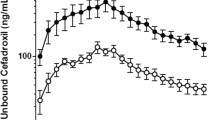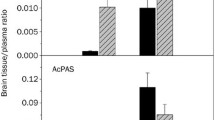Abstract
Recent studies indicate that inhibition of the efflux transporter P-glycoprotein (P-gp) at the blood–brain barrier (BBB) may represent a putative strategy to increase the BBB penetration of several antibiotics. Therefore, the present study aimed to investigate the effect of P-gp inhibition on the transport of ceftriaxone (CFX) across the BBB. Blood and brain microdialysis in rats was used to monitor blood and brain unbound CFX concentrations following intravenous administration (50 mg/kg), with or without pretreatment with one of the P-gp inhibitors, cyclosporin A (6.25, 12.5, 25 mg/kg) or verapamil (5, 10, 20 mg/kg). An inhibitory effect was demonstrated by an increase in the ratio of unbound brain to unbound blood concentration (Kp.uu.brain) of CFX. The concentrations of CFX in blood and brain from 0 to 180 min after intravenous administration (CFX, 50 mg/kg) ranged from 3 to 40 μg/ml and 1 to 10 μg/ml, respectively. The Kp.uu.brain of CFX was 24.74 ± 1.34%. Pretreatment with cyclosporin A increased the brain concentration and the Kp.uu.brain of CFX in a dose-dependent manner. However, pretreatment with verapamil increased the brain concentration of CFX but not the Kp.uu.brain. The present data shows that CFX might be a substrate of P-gp efflux transporter at the BBB and P-gp inhibition might enhance the brain concentration of CFX. Future studies involving more selective P-gp inhibitors or knockout mouse models should be conducted to specifically elucidate the impact of P-gp inhibition on penetration of CFX across the BBB.






Similar content being viewed by others
References
Oordt-Speets AM, Bolijn R, van Hoorn RC, Bhavsar A, Kyaw MH (2018) Global etiology of bacterial meningitis: a systematic review and meta-analysis. PLoS One 13:e0198772
Young N, Thomas M (2018) Meningitis in adults: diagnosis and management. Intern Med J 48:1294–1307
van de Beek D, Cabellos C, Dzupova O, Esposito S, Klein M, Kloek AT, Leib SL, Mourvillier B, Ostergaard C, Pagliano P, Pfister HW, Read RC, Sipahi OR, Brouwer MC, Brain ESGfIot (2016) ESCMID guideline: diagnosis and treatment of acute bacterial meningitis. Clin Microbiol Infect 22(Suppl 3):S37-62
van de Beek D, Brouwer MC, Thwaites GE, Tunkel AR (2012) Advances in treatment of bacterial meningitis. Lancet 380:1693–1702
Weinstein MP, Klugman KP, Jones RN (2009) Rationale for revised penicillin susceptibility breakpoints versus Streptococcus pneumoniae: coping with antimicrobial susceptibility in an era of resistance. Clin Infect Dis 48:1596–1600
Granero L, Santiago M, Cano J, Machado A, Peris JE (1995) Analysis of ceftriaxone and ceftazidime distribution in cerebrospinal fluid of and cerebral extracellular space in awake rats by in vivo microdialysis. Antimicrob Agents Chemother 39:2728–2731
Nau R, Prange HW, Muth P, Mahr G, Menck S, Kolenda H, Sorgel F (1993) Passage of cefotaxime and ceftriaxone into cerebrospinal fluid of patients with uninflamed meninges. Antimicrob Agents Chemother 37:1518–1524
Furtado D, Bjornmalm M, Ayton S, Bush AI, Kempe K, Caruso F (2018) Overcoming the blood-brain barrier: the role of nanomaterials in treating neurological diseases. Adv Mater 30:e1801362
Park TE, Mustafaoglu N, Herland A, Hasselkus R, Mannix R, FitzGerald EA, Prantil-Baun R, Watters A, Henry O, Benz M, Sanchez H, McCrea HJ, Goumnerova LC, Song HW, Palecek SP, Shusta E, Ingber DE (2019) Hypoxia-enhanced blood-brain barrier chip recapitulates human barrier function and shuttling of drugs and antibodies. Nat Commun 10:2621
Nau R, Sorgel F, Eiffert H (2010) Penetration of drugs through the blood-cerebrospinal fluid/blood-brain barrier for treatment of central nervous system infections. Clin Microbiol Rev 23:858–883
Hu K, Xie X, Zhao YN, Li Y, Ruan J, Li HR, Jin T, Yang XL (2015) Chitosan influences the expression of P-gp and metabolism of norfloxacin in grass carp. J Aquat Anim Health 27:104–111
Lagas JS, Sparidans RW, van Waterschoot RA, Wagenaar E, Beijnen JH, Schinkel AH (2008) P-glycoprotein limits oral availability, brain penetration, and toxicity of an anionic drug, the antibiotic salinomycin. Antimicrob Agents Chemother 52:1034–1039
Worzfeld T, Schwaninger M (2016) Apicobasal polarity of brain endothelial cells. J Cereb Blood Flow Metabol 36:340–362
Gosland MP, Lum BL, Sikic BI (1989) Reversal by cefoperazone of resistance to etoposide, doxorubicin, and vinblastine in multidrug resistant human sarcoma cells. Can Res 49:6901–6905
Heckler RP, Almeida GD, Santos LB, Borges DG, Neves JP, Onizuka MK, Borges FA (2014) P-gp modulating drugs greatly potentiate the in vitro effect of ivermectin against resistant larvae of Haemonchus placei. Vet Parasitol 205:638–645
Allegra S, Cardellino CS, Fatiguso G, Cusato J, De Nicolo A, Avataneo V, Bonora S, D’Avolio A, Di Perri G, Calcagno A (2018) Effect of ABCC2 and ABCG2 gene polymorphisms and CSF-to-serum albumin ratio on ceftriaxone plasma and cerebrospinal fluid concentrations. J Clin Pharmacol 58:1550–1556
O’Brien FE, Clarke G, Fitzgerald P, Dinan TG, Griffin BT, Cryan JF (2012) Inhibition of P-glycoprotein enhances transport of imipramine across the blood-brain barrier: microdialysis studies in conscious freely moving rats. Br J Pharmacol 166:1333–1343
Kovar A, Dalla Costa T, Derendorf H (1997) Comparison of plasma and free tissue levels of ceftriaxone in rats by microdialysis. J Pharm Sci 86:52–56
Zimmermann ES, de Miranda SC, Neris C, Torres B, Schmidt S, Dalla Costa T (2019) Population pharmacokinetic modeling to establish the role of P-glycoprotein on ciprofloxacin distribution to lung and prostate following intravenous and intratracheal administration to Wistar rats. Eur J Pharma Sci 127:319–329
Tasso L, Bettoni CC, Oliveira LK, Dalla Costa T (2008) Evaluation of gatifloxacin penetration into skeletal muscle and lung by microdialysis in rats. Int J Pharm 358:96–101
Chen C, Zhou H, Guan C, Zhang H, Li Y, Jiang X, Dong Z, Tao Y, Du J, Wang S, Zhang T, Du N, Guo J, Wu Y, Song Z, Luan H, Wang Y, Du H, Zhang S, Li C, Chang H, Wang T (2020) Applicability of free drug hypothesis to drugs with good membrane permeability that are not efflux transporter substrates: a microdialysis study in rats. Pharmacol Res Perspect 8:e00575
Mercolini L, Mandrioli R, Iannello C, Matrisciano F, Nicoletti F, Raggi MA (2009) Simultaneous analysis of diazepam and its metabolites in rat plasma and brain tissue by HPLC-UV and SPE. Talanta 80:279–285
Li S, Cao W, Hui YS, Wen W (2014) Simple and reusable picoinjector for liquid delivery via nanofluidics approach. Nanoscale Res Lett 9:147
Glowka FK, Hermann TW, Danielak D, Zabel M, Hermann J (2019) Bioavailability of moclobemide from two formulation tablets in healthy humans. Pharmazie 74:97–100
Liu H, Dong K, Zhang W, Summerfield SG, Terstappen GC (2018) Prediction of brain:blood unbound concentration ratios in CNS drug discovery employing in silico and in vitro model systems. Drug Discovery Today 23:1357–1372
Gu L, Ma M, Zhang Y, Zhang L, Zhang S, Huang M, Zhang M, Xin Y, Zheng G, Chen S (2019) Comparative pharmacokinetics of tedizolid in rat plasma and cerebrospinal fluid. Regulat Toxicol Pharmacol 107:104420
Chang YL, Chou MH, Lin MF, Chen CF, Tsai TH (2001) Effect of cyclosporine, a P-glycoprotein inhibitor, on the pharmacokinetics of cefepime in rat blood and brain: a microdialysis study. Life Sci 69:191–199
Dankner WM, Connor JD, Sawyer M, Straube R, Spector SA (1988) Treatment of bacterial meningitis with once daily ceftriaxone therapy. J Antimicrob Chemother 21:637–645
Martin E, Koup JR, Paravicini U, Stoeckel K (1984) Pharmacokinetics of ceftriaxone in neonates and infants with meningitis. J Pediatr 105:475–481
Garcia-Varela L, Vallez Garcia D, Rodriguez-Perez M, van Waarde A, Sijbesma JWA, Schildt A, Kwizera C, Aguiar P, Sobrino T, Dierckx R, Elsinga PH, Luurtsema G (2020) Test-retest repeatability of [(18)f]mc225-pet in rodents: a tracer for imaging of P-gp function. ACS Chem Neurosci 11:648–658
Latif R, Dajani AS (1983) Ceftriaxone diffusion into cerebrospinal fluid of children with meningitis. Antimicrob Agents Chemother 23:46–48
Del Rio M, McCracken GH Jr, Nelson JD, Chrane D, Shelton S (1982) Pharmacokinetics and cerebrospinal fluid bactericidal activity of ceftriaxone in the treatment of pediatric patients with bacterial meningitis. Antimicrob Agents Chemother 22:622–627
Gupta A, Chatelain P, Massingham R, Jonsson EN, Hammarlund-Udenaes M (2006) Brain distribution of cetirizine enantiomers: comparison of three different tissue-to-plasma partition coefficients: K(p), K(p, u), and K(p, uu). Drug Metabol Disposit 34:318–323
Bengtsson J, Ederoth P, Ley D, Hansson S, Amer-Wahlin I, Hellstrom-Westas L, Marsal K, Nordstrom CH, Hammarlund-Udenaes M (2009) The influence of age on the distribution of morphine and morphine-3-glucuronide across the blood-brain barrier in sheep. Br J Pharmacol 157:1085–1096
Morita N, Kusuhara H, Sekine T, Endou H, Sugiyama Y (2001) Functional characterization of rat organic anion transporter 2 in LLC-PK1 cells. J Pharmacol Exp Ther 298:1179–1184
Liao XY, Deng QQ, Han L, Wu ZT, Peng ZL, Xie Y, Wang GJ, Aa JY, Pan GY (2020) Leflunomide increased the renal exposure of acyclovir by inhibiting OAT1/3 and MRP2. Acta Pharmacol Sin 41:129–137
Hagos FT, Daood MJ, Ocque JA, Nolin TD, Bayir H, Poloyac SM, Kochanek PM, Clark RS, Empey PE (2017) Probenecid, an organic anion transporter 1 and 3 inhibitor, increases plasma and brain exposure of N-acetylcysteine. Xenobiotica 47:346–353
Liu J, Zhang N, Li N, Fan X, Li Y (2019) Influence of verapamil on the pharmacokinetics of oridonin in rats. Pharm Biol 57:787–791
Huang Y, Zhao J, Jian W, Wang G (2018) Effects of verapamil on the pharmacokinetics of dihydromyricetin in rats and its potential mechanism. Xenobiotica 48:839–844
Wang X, Zhang X, Huang X, Li Y, Wu M, Liu J (2016) The drug-drug interaction of sorafenib mediated by P-glycoprotein and CYP3A4. Xenobiotica 46:651–658
Hanko E, Tommarello S, Watchko JF, Hansen TW (2003) Administration of drugs known to inhibit P-glycoprotein increases brain bilirubin and alters the regional distribution of bilirubin in rat brain. Pediatr Res 54:441–445
Li L, Yao QQ, Xu SY, Hu HH, Shen Q, Tian Y, Pan LY, Zhou H, Jiang HD, Lu C, Yu LS, Zeng S (2014) Cyclosporin A affects the bioavailability of ginkgolic acids via inhibition of P-gp and BCRP. Eur J Pharma Biopharma 88:759–767
Yang Y, Li P, Zhang Z, Wang Z, Liu L, Liu X (2020) Prediction of Cyclosporin-Mediated Drug Interaction Using Physiologically Based Pharmacokinetic Model Characterizing Interplay of Drug Transporters and Enzymes. Int J Mol Sci 21:7023
Acknowledgements
This work was supported by the Military medical technology youth program of China [Grant number 17QNP060].
Funding
This work was supported by the Military medical technology youth program of China [Grant Number 17QNP060].
Author information
Authors and Affiliations
Contributions
SYH performed all experiments and wrote the manuscript; CYY, ZYJ, TRS, and ZJH helped with the animal experiments study; ZJT, NZY, and YSY conducted and supervised the whole experiments. All authors read and approved the final manuscript.
Corresponding authors
Ethics declarations
Conflict of interest
None.
Ethical Approval
Animal care and use were in accordance with the NIH Guide for the Care and Use of Laboratory Animals (NIH Publication 85–23, Bethesda, MD) and approved by the Committee on Animal Use for Research and Education of the Laboratory Animals Centre, General Hospital of Chinese People’s Liberation Army (Beijing, China).
Additional information
Publisher's Note
Springer Nature remains neutral with regard to jurisdictional claims in published maps and institutional affiliations.
Supplementary Information
Below is the link to the electronic supplementary material.
Rights and permissions
About this article
Cite this article
Shan, Y., Cen, Y., Zhang, Y. et al. Effect of P-glycoprotein Inhibition on the Penetration of Ceftriaxone Across the Blood–Brain Barrier. Neurochem Res 47, 634–643 (2022). https://doi.org/10.1007/s11064-021-03472-1
Received:
Revised:
Accepted:
Published:
Issue Date:
DOI: https://doi.org/10.1007/s11064-021-03472-1




